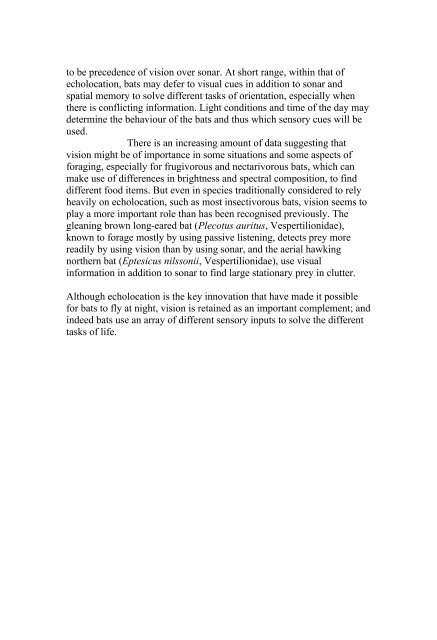Vision in echolocating bats - Fladdermus.net
Vision in echolocating bats - Fladdermus.net
Vision in echolocating bats - Fladdermus.net
You also want an ePaper? Increase the reach of your titles
YUMPU automatically turns print PDFs into web optimized ePapers that Google loves.
to be precedence of vision over sonar. At short range, with<strong>in</strong> that of<br />
echolocation, <strong>bats</strong> may defer to visual cues <strong>in</strong> addition to sonar and<br />
spatial memory to solve different tasks of orientation, especially when<br />
there is conflict<strong>in</strong>g <strong>in</strong>formation. Light conditions and time of the day may<br />
determ<strong>in</strong>e the behaviour of the <strong>bats</strong> and thus which sensory cues will be<br />
used.<br />
There is an <strong>in</strong>creas<strong>in</strong>g amount of data suggest<strong>in</strong>g that<br />
vision might be of importance <strong>in</strong> some situations and some aspects of<br />
forag<strong>in</strong>g, especially for frugivorous and nectarivorous <strong>bats</strong>, which can<br />
make use of differences <strong>in</strong> brightness and spectral composition, to f<strong>in</strong>d<br />
different food items. But even <strong>in</strong> species traditionally considered to rely<br />
heavily on echolocation, such as most <strong>in</strong>sectivorous <strong>bats</strong>, vision seems to<br />
play a more important role than has been recognised previously. The<br />
glean<strong>in</strong>g brown long-eared bat (Plecotus auritus, Vespertilionidae),<br />
known to forage mostly by us<strong>in</strong>g passive listen<strong>in</strong>g, detects prey more<br />
readily by us<strong>in</strong>g vision than by us<strong>in</strong>g sonar, and the aerial hawk<strong>in</strong>g<br />
northern bat (Eptesicus nilssonii, Vespertilionidae), use visual<br />
<strong>in</strong>formation <strong>in</strong> addition to sonar to f<strong>in</strong>d large stationary prey <strong>in</strong> clutter.<br />
Although echolocation is the key <strong>in</strong>novation that have made it possible<br />
for <strong>bats</strong> to fly at night, vision is reta<strong>in</strong>ed as an important complement; and<br />
<strong>in</strong>deed <strong>bats</strong> use an array of different sensory <strong>in</strong>puts to solve the different<br />
tasks of life.<br />
5


